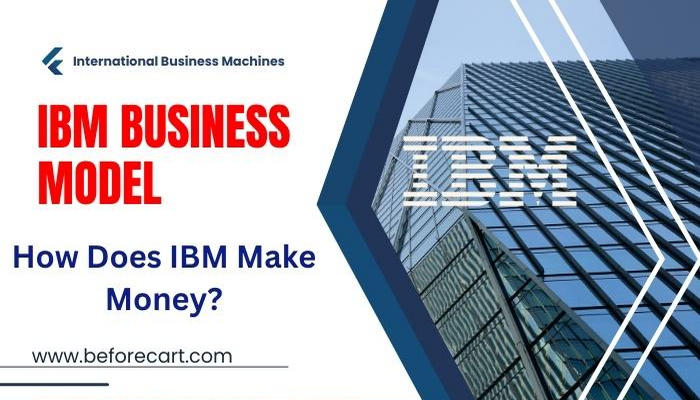Have you ever wondered, “How Does IBM Make Money?” In the world of big tech companies, IBM shines the brightest. Let’s explore how IBM does its business or IBM Business Model. It’s not just about computers and programs – there’s more to discover. We’ll explore how strategies, collaborations, and futuristic visions come together. Get ready to discover the heart of IBM’s revenue strategies, where cloud expertise, innovation, and smart planning shape the future of tech. Join us as we unravel the secrets behind IBM’s success and see how they’re shaping the world of technology.
IBM Business Model: How Does IBM Make Money?
Table of Contents
Understanding IBM’s Business Model:
Understanding the principles of the IBM Business Model before learning how the organization generates income is critical. As a technology solutions provider, IBM offers diverse goods and services, including hardware, software, consulting, and more. This integrated strategy enables them to service a comprehensive customer with various needs.
Credits: @DenisOakleyStrategyConsulting
IBM’s business model leverages its decades-long experience and industry expertise. By offering a comprehensive suite of solutions, IBM addresses clients’ technology needs at various levels. This approach allows them to establish long-term relationships and maintain a steady revenue stream from diverse sources.
Revenue Streams and Monetization Strategies:
IBM’s business model is built on various revenue streams that work in tandem to provide stability and growth. Among these revenue streams are:
a. Hardware Sales: IBM has a significant hardware legacy. IBM provides sectors that require strong computing solutions with products ranging from mainframes to high-performance computing systems. These hardware sales account for a sizable amount of IBM’s total income.
b. Software Licensing: IBM’s business model is built around the software segment. They provide a variety of software solutions including as analytics, artificial intelligence, cloud computing, and others. Clients pay for licenses, subscriptions, and use fees, which contribute significantly to IBM’s income.
c. Services: Consulting and professional services are another important source of revenue for IBM. Businesses all across the world rely on IBM’s experience to streamline operations, adopt technology solutions, and improve overall productivity. These services account for a sizable amount of company earnings.
d. Cloud Services: IBM’s push into cloud computing has been game-changing. Businesses searching for scalable and secure cloud solutions are the target audience for their hybrid cloud approach, which mixes public and private cloud products. In recent years, this market has expanded and developed into a considerable source of income.
e. Strategic Partnerships: IBM’s revenue is boosted by collaborations with other tech titans and strategic relationships. A classic example is the acquisition of Red Hat, a leader in open-source solutions. Such collaborations broaden IBM’s customer base and products, resulting in revenue growth.
The Power of IBM’s Hybrid Cloud Strategy:
The IBM business model’s hybrid cloud approach is a crucial component. IBM’s hybrid strategy delivers a combination of public and private clouds in a digital environment where cloud adoption is driving change. This innovative approach not only makes money from cloud services but also establishes IBM as a pioneer in offering adaptable and secure cloud solutions catered to various customer requirements.
Businesses of all sizes may shift to cloud-based operations using IBM’s hybrid cloud strategy while solving security, scalability, and customization issues. This novel strategy exemplifies IBM’s business model’s flexibility and dedication to meet changing customer expectations.
Client-Centric Innovation and Long-Term Partnerships:
Long-term client connections are a cornerstone of IBM’s business strategy. Instead of providing one-time fixes, IBM’s business strategy emphasizes ongoing innovation and customization.
IBM cultivates durable connections that lead to repeat business and consistent income by matching their services with the objectives and problems of their clients. Understanding each client’s particular demands and developing specialized solutions are part of IBM’s client-centric strategy.
As a result, confidence is increased and they are further cemented as a trustworthy technological partner. As pleased clients continue to seek out IBM’s services and solutions, these established connections have a substantial financial impact on the company.
Valuation and Funding:
The story of IBM’s valuation and finance, which reflects its enduring heritage, is at the center of the company’s history. IBM is a testimony to innovation’s enduring strength, with a valuation that reflects its status as a tech pioneer. Because of its sound financial standing, it has drawn significant support throughout the years, enabling ground-breaking developments that have shaped the technical environment.

Resources that have opened the way for game-changing projects, major acquisitions, and revolutionary enterprises have been committed to IBM by investors and stakeholders. The financing synergy has strengthened IBM’s capacity to develop, adapt, and flourish in a market that is evolving quickly.
IBM’s valuation and finance remain crucial to its development and impact story as the IT industry develops. They are the driving force behind IBM’s quest of excellence and are more than simply numbers on a balance sheet. The basis upon which IBM continues to create a tale of innovation, resiliency, and long-term success is this synergy of valuation and finance.
IBM Competitors:
The competitive environment in the technology sector pits IBM against numerous strong competitors. While IBM’s business strategy has catapulted it to the forefront of innovation, knowing who its rivals are will give you a full picture of the market’s dynamics. Let’s examine some of the main rivals that threaten IBM’s dominance and add to the computer industry’s dynamic interaction.
1. Microsoft Corporation
A global technology giant, Microsoft offers diverse software, hardware, and cloud services. With products like Windows, Office suite, and Azure cloud platform, Microsoft competes with IBM’s software and cloud offerings. The battle for dominance in cloud computing and enterprise solutions is one of the key arenas where IBM and Microsoft lock horns.
To gain deeper insights into the tech landscape, explore our article on the Microsoft Business Model.
2. Amazon Web Services (AWS)
IBM and Amazon Web Services (AWS) are engaged in a fierce battle for market dominance in cloud computing. The way businesses utilize the cloud has radically altered thanks to AWS, Amazon’s cloud subsidiary. A serious obstacle to IBM’s cloud aspirations is AWS, which has a vast infrastructure, state-of-the-art services, and a constant focus on innovation.
The conflict between AWS and IBM exemplifies the struggle for scalability, security, and seamless digital transformation as both titans compete for supremacy in the ever-expanding cloud world. Join us for a gripping battle of the titans of the cloud, where every innovation is a planned move, every service is a calculated move, and every client’s success is a crucial triumph.
Unveiling the Cloud Battle: AWS vs. IBM – Click here to uncover how Amazon Web Services (AWS) challenges IBM’s cloud dominance and discover the secrets behind Amazon’s triumphant Business Model.
If you want to know how strong Amazon is, you may read our other article, Amazon Stock Forecast.
3. Oracle Corporation
When it comes to databases, clouds, and business software, IBM takes the stage. They’re masters in data management and high-tech solutions. But hold on tight – they’re going head-to-head with Oracle, especially in areas like data handling and cloud services. The competition is fierce, covering database technologies, cloud databases, and enterprise solutions. Imagine two tech giants battling it out for supremacy!
4. SAP SE
Enterprise resource planning (ERP) and business applications are two areas where SAP is famous for its business software solutions. The SAP application package, which serves a range of sectors, including manufacturing, shipping, and finance, competes with IBM’s consulting and services.
5. Google Cloud Platform
Google has its own cloud stuff called Google Cloud Platform (GCP). They’re up against IBM’s cloud stuff too. Google knows a lot about data stuff, like analytics and smart tech. That’s where they compete with IBM. They both want to help companies with super-smart cloud services and cool data tricks. It’s like a tech face-off!
6. Dell Technologies
Dell Technologies offers a wide range of products, including computer hardware, software, and useful services. In certain ways, IBM and Dell are competitors. They both produce server and storage equipment. Dell, like some portions of IBM, is all about data management, manufacturing phony replicas of things, and tech solutions. It’s almost like a gigantic tech game!
7. Hewlett Packard Enterprise (HPE)
HPE is yet another hardware and IT solutions competitor. IBM and HPE are both providers of enterprise server, storage, and networking solutions. Competition also exists in the areas of hybrid cloud integration, data center management, and IT services.
These competitors, among others, challenge IBM’s market dominance, innovation, and client base in the ever-changing technology landscape. Competition generates improvements, innovation, and distinction, benefiting businesses and consumers through various options and technical advancement.
Frequently Asking Questions:
Here are some frequently asked questions about the IBM Business Model:
What is the primary source of IBM’s revenue?
IBM generates revenue in lots of cool ways. They sell computer parts, let people use their software, give helpful services, and even have cloud stuff. Plus, they team up with other companies for smart partnerships. That’s how they make their revenue!
How does IBM’s hybrid cloud strategy contribute to its revenue?
IBM has a super plan called a hybrid cloud strategy. It helps businesses find safe and significant cloud solutions that can grow with them. This plan makes money from the cloud services it offers. And guess what? It also makes IBM a leader in cloud tech. They’re like the boss of cloud technology!
How does IBM ensure long-term revenue growth?
IBM makes sure it has money coming in for a long time by being really good at helping other companies with their technology needs. They build strong friendships with these companies and keep making new and better things that the companies want.
This way, the companies keep coming back to IBM for more help, and IBM keeps getting money. It’s like being a helpful friend and always coming up with cool ideas!
What role do strategic partnerships play in IBM’s revenue generation?
IBM formed savvy alliances, such as when it acquired Red Hat. Working together helps their products and customers flourish, and they make more money. It’s similar to how collaboration helps IBM improve!
What is IBM Business Strategy 2024?
IBM plans to accelerate technological progress by 2024. They also wish to assist people in learning new talents and trying new activities. They’re experimenting with novel concepts like clever AI. It’s as though IBM’s CEO is planning something fantastic!
Conclusion: IBM’s Revenue Diversity and Sustainable Growth
In the tech world that’s constantly changing, IBM has a super plan for success. They don’t just rely on one thing for money. They have different ways to generate revenue, like computer parts, programs, helping out, and working with other big companies.
This intelligent plan protects them from putting all their eggs in one basket. Even in a big competition, IBM keeps going strong because they always develop new ideas and consider what people need. They’re like tech superheroes!
Final Thoughts:
Understanding how IBM gets money tells us about their intelligent choices, new ideas, and working with friends. IBM’s business is like having many ways to earn money – selling things, helping others, and using clouds. They work with others, too! This mix of stuff makes IBM get bigger and better in tech.
As tech keeps changing, IBM needs to change too. They must keep developing new ideas and working with friends to do well. They also help their customers a lot. IBM is ready for all the tech changes ahead!IBM has a clever plan that teaches us how being ready for change is super important. They started with computer parts and now do big things in the cloud with helpful friends. IBM is like a tech leader, making the tech world awesome!
As tech changes, IBM changes too. They’re great at making new ideas, being ready for anything, and making customers happy. Learning how they make money shows how they became a big deal in tech!
After reading this, you have learned so many things about the IBM Business Model. Do you still have something on your mind or have questions? Just write in the comments below! We’re excited to hear what you think. We want to know what you think. Your ideas make the talk even cooler.





